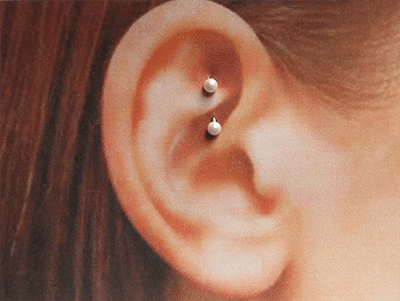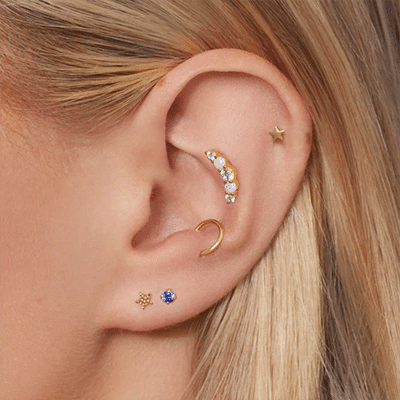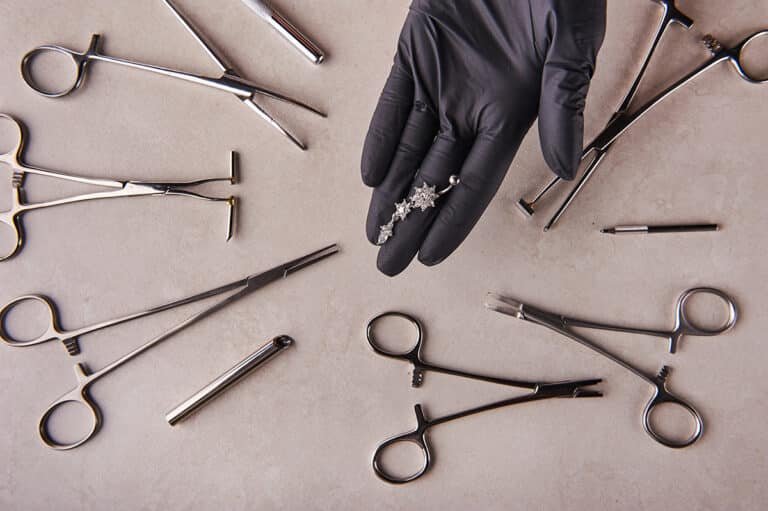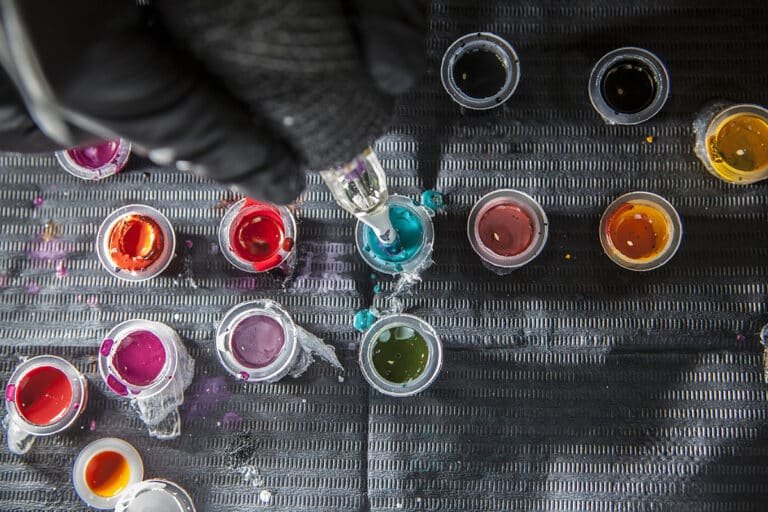The Rook piercing is a popular type of ear piercing that has gained popularity in recent years. While this piercing may seem like a simple process, it’s important to understand the healing process and how long it takes for your piercing to fully heal.
What Are Rook Piercings?
A rook piercing is a type of ear and cartilage piercing. The rook piercing placement is done through the upper cartilage ridge of the ear, which is called the antihelix. It is located above the tragus and below the daith – hence the familiar tragus and daith piercings, creating a unique look that has become extremely popular in recent years.
Rook piercings are typically done with a curved barbell or a captive bead ring and can be adorned with various types of jewelry such as studs or hoops, depending on your personal preference.
Other Common Ear Piercings
There are many different types of ear piercings, each with its unique location and name. Some common ear piercings include:
- Helix piercing: This piercing goes through the upper cartilage rim of the ear.
- Tragus piercing: Located in the small flap of cartilage that covers the ear canal.
- Conch piercing: This can either be a perforation of the outer or inner cartilage of the ear.
- Daith piercing: This piercing is done through the fold of cartilage above the ear canal.
The Piercing Process
Before getting a rook piercing, it’s important to choose a reputable piercer who uses sterile equipment and follows proper hygiene practices. The piercing process involves the following steps:
- Marking the spot: The piercer will mark where the piercing will be done on your ear.
- Sterilization: Your ear will be thoroughly cleaned with an antiseptic solution by piercing professionals.
- Piercing: Using a sterilized hollow needle the piercer will make a hole through your cartilage.
- Inserting jewelry: The type of jewelry will be the starter jewelry of your choice and inserted into the new piercing.
- Aftercare instructions: Your professional piercer will provide you with piercing aftercare instructions to follow for proper healing.
The Healing Process
Like any other body piercing, a rook piercing requires proper aftercare to ensure that your new piercing is completely healed with no scar tissue or allergic reaction. A rook piercing takes anywhere from 6 to 12 months of healing time, depending on individual factors such as the person’s immune system and how well they follow the piercer’s instructions and keep the piercing area clean.
In general, the healing process for a rook piercing goes through three stages:
- Inflammation: This stage will occur immediately after getting your piercing and can last up to one week. During this time, the pierced area may be sore, swollen, and red.
- Granulation Tissue Formation: During this stage, which lasts from one to four weeks, the body starts to heal and form granulation tissue (new blood vessels) around the piercing site.
- Epithelization: This is the final stage of healing where new skin forms over the surface of the piercing. It can take anywhere from four to six months or longer for this process to complete.
What to Expect During Healing
During the initial healing period, it is normal for the area to be red, swollen, and tender. There may also be some bleeding, discharge, and crust formation. This is the body’s natural response to healing and is not a cause for concern.
It’s important to avoid touching or playing with your piercing during this time as it can introduce bacteria and prolong the healing process. It’s also recommended to avoid sleeping on the pierced ear, to clean the area twice a day with a sterile saline solution or mild soap, and avoid anything like hydrogen peroxide, alcohol, or Neosporin.
You may encounter bumps, especially with cartilage piercings. These are usually caused by trauma or irritation and can be treated with warm compresses and gentle cleaning. However, if the bump persists or becomes increasingly painful, it’s best to consult your piercer or a medical professional.
Rook Piercing Jewelry
During the healing process, it’s important to wear appropriate starter jewelry that does not irritate the piercing. This means avoiding materials such as nickel or low-quality metals that can cause allergic reactions or infections. The APP recommends using jewelry made of surgical steel, titanium, or 14k gold during the initial healing period.
Once your piercing is fully healed, you can change to different types of jewelry such as studs or hoops. It’s essential to keep the area clean and avoid wearing heavy or dangling earrings that could put pressure on the piercing. Your piercer will typically use a curved barbell for a rook piercing, but once it has fully healed, you can switch to different types of earrings such as hoops or studs!
Rad Ink on 192 has an awesome selection of body jewelry and jewelry materials to choose from once your initial piercing has healed. You’re sure to find curved barbells, hoops, or studs that suit your unique style and personality!
Rook Piercing Pain
While it’s normal to experience some discomfort during the healing process, certain signs may indicate an infection. These include excessive swelling, redness spreading beyond the piercing site, severe pain, and foul-smelling discharge.
If you notice any of these symptoms, it’s important to seek medical attention as soon as possible. Your piercer or a healthcare professional can guide how to properly treat the infection and prevent it from worsening.
Piercing Aftercare Tips for Faster Healing
Here are some helpful tips to keep in mind from a professional piercer to make sure your rook piercing heals quickly:
- Follow the piercing aftercare instructions provided by your piercer ie aftercare sprays
- Avoid touching or playing with the new piercing.
- Clean the piercing area twice a day with a sterile saline solution or mild soap and gently wipe dry with a clean paper towel.
- Avoid sleeping on the pierced ear, sleep on the opposite side so it can completely heal.
- Eat a healthy diet and stay hydrated to support your body’s natural healing process.
- Do not go swimming in any bodies of water, pools, or hot tubs for the first few weeks.
The healing process for a rook piercing can take anywhere from 6 to 12 months. It’s important to properly care for your piercing during this time and be aware of potential signs of infection. With proper aftercare, you can enjoy your new rook piercing for years to come. So, if you’re considering getting a rook piercing, make sure to do your research and find a reputable piercer who can guide you through the healing process. And remember, patience is key when it comes to body piercing healing.
Get Pierced At Rad Ink
We prioritize safety and cleanliness when it comes to body piercings at Rad Ink in Melbourne. Our experienced piercers use sterile equipment and follow proper hygiene practices to ensure a safe and comfortable piercing experience. So, if you’re ready to get your rook pierced, come on in and meet our professional piercers today! Our team will guide you through the process and provide you with piercing aftercare instructions to ensure proper healing. Don’t wait any longer, come get pierced at Rad Ink and make a statement with your new rook piercing!
No Appointment Needed
At Rad Ink, we understand that getting a new piercing can be spontaneous and exciting. That’s why we welcome walk-ins for all body piercings including rook piercings. So, if you suddenly decide to get your rook pierced, feel free to stop by our shop and our team will take care of you! We also offer a wide selection of body jewelry for you to choose from, so you can find the perfect piece to show off your new rook piercing. Visit Rad Ink in Melbourne, Florida today and add a stylish and unique touch to your look with a rook piercing. See you soon!
Rad FAQs
What’s a daith piercing?
A daith piercing is a type of ear piercing that goes through the innermost cartilage fold of the ear. It’s said to have therapeutic benefits for migraine relief, but there is no scientific evidence to support this claim. Nevertheless, it makes for a unique and stylish addition to your ear piercings!
What’s a tragus piercing?
A tragus piercing is a piercing on the small, thick piece of cartilage located in front of the ear canal, covering your inner ear. It’s another popular ear piercing that can be adorned with various types of jewelry.
What’s the average cost for a cartilage piercing?
The cost of a cartilage piercing can vary depending on the location, piercer, and type of jewelry chosen. On average, it can range from $30 to $100.
Does a rook piercing hurt?
The pain level can vary from person to person, but generally, a rook piercing is described as moderate to slightly painful due to it going through a very thick layer of ear cartilage.
How long does it take for a rook piercing to stop hurting?
The initial pain and discomfort usually subside after a few days or weeks. However, it’s important to avoid irritating the piercing during this time to prevent prolonging the healing process. If you experience ongoing pain or discomfort, it’s best to consult with your piercer or a healthcare professional.
Can I change my jewelry before my rook piercing is fully healed?
It’s not recommended to change your jewelry before your piercing has fully healed, as this can disrupt the healing process and increase the risk of infection. It’s best to wait until your piercer gives the go-ahead or consult with them before making any changes to your jewelry.
How old do you have to be in Florida to get a rook piercing?
In Florida, the legal age to get a piercing without parental consent is 18 years old. However, some piercers may have their own age restrictions, so it’s best to check with them beforehand. If you are under 18, you will need parental consent and possibly be accompanied by a parent or guardian during the piercing process.
Can I swim with a rook piercing?
It’s best to avoid swimming in public pools or bodies of water with a newly pierced rook. These environments can contain bacteria and increase the risk of infection. If you do choose to swim, make sure to thoroughly clean your piercing afterward and avoid submerging it in water for long periods. It’s also recommended to wait until your piercing is fully healed before swimming.
How do I know if I have a piercing infection?
Signs of a piercing infection may include excessive swelling, redness, warmth, and pain at the piercing site. There may also be discharge that is yellow or green and has a foul odor. If you suspect an infection, it’s important to seek medical attention as soon as possible. Your piercer or healthcare professional can guide you on how to properly treat the infection and prevent it from worsening. It’s also important to follow proper piercing aftercare measures to prevent infections in the first place. If you have any concerns or questions about your piercing, don’t hesitate to reach out to a professional for guidance. Your health and well-being should always be a top priority when getting a body piercing.
Can I use a sea salt soak on my new rook piercing?
While sea salt soaks have been a popular aftercare method for piercings, it’s not recommended for rook piercings. The thick layer of cartilage in the rook area can make it difficult for salt water to properly cleanse the piercing, increasing the risk of infection. It’s best to stick to sterile saline solution or mild soap and water when cleaning a rook piercing.











